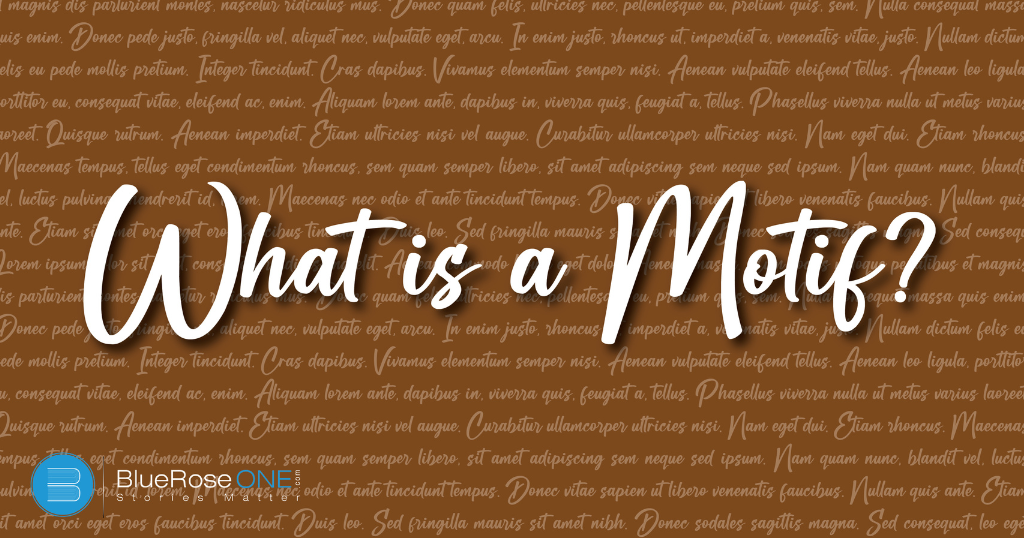
What is a Motif in Literature? Definition, Meaning and Examples
In the world of stories and books, there’s something special called a “motif.” It’s like a magical ingredient that adds meaning and beauty to the tale. Imagine it as a dance, where this special element keeps popping up, making the story richer and more interesting. In our adventure today, we’re going to explore what motifs are all about. Think of it as a journey where every time something repeats in a story, it’s like a secret code or a lovely tune that makes everything more special. Come along as we discover the simple yet fascinating world of motifs in literature – the hidden gems that make stories come alive. You may also like: How to Write an Author Bio | BlueRoseOne.com Defining Motif in Literature In literature, a motif is like a special pattern or theme that repeats in a story. The word “motif” comes from French and means a pattern or theme. Unlike big ideas called themes, motifs are specific details, concepts, or structures that show up over and over again in a literary work, adding layers of meaning. Picture a motif as a repeated melody in a song. Each time you hear it, it brings something new to the music. Similarly, in stories, a motif is a particular element or image that keeps coming back, changing and growing as the plot unfolds. It’s like a special ingredient that authors use to give their work a unique and recognizable flavor. Take the example of a rose as a motif in a story. At first, it might mean love and beauty. But as the story goes on, the same rose could start to symbolize different things – maybe showing how relationships are fragile or how time passes. This changing nature of motifs makes them different from fixed themes. Writers use motifs to add intricate symbols to their stories, connecting with readers on a deeper level. Motifs act like building blocks in a story, connecting different parts together. They link characters, events, and feelings, creating a solid narrative. By repeating and changing, motifs become a kind of secret language within the story. They can communicate complex ideas and emotions without directly saying them. In simple terms, motifs are like tools for storytellers. They help make a tale more than just about the surface-level plot and characters. They are like secret codes that, when you understand them, reveal hidden meanings and deep layers in literature. As we explore motifs, we’re uncovering the special craft that writers use to turn words into immersive and meaningful stories. You may also read: 5 Act Structure: Definition, Examples and More Key Characteristics of Motifs: You may also like: 7 Top Rated Self Help Books of All time in 2024 Exploring the Meaning of Motifs: You may also like: Publish your book with Amazon Self-Publishing in 2024 Examples of Motifs in Literature You may also like: List of 10 Best Libraries in Portsmouth for Book Lovers You may also read: Left Behind Series Books in Order: Where to Begin The Evolution of Motifs You may also like: How to Avoid Plagiarism in Assignment: 10 Easy Steps In the vast landscape of literature, motifs emerge as intricate threads that connect the fabric of storytelling. Through their repetition, symbolic significance, and contribution to overarching themes, motifs enrich the reader’s experience and offer a nuanced understanding of complex narratives. As we journey through the pages of diverse literary works, the motifs we encounter serve as guiding lights, inviting us to unravel the profound meanings woven into the tapestry of human expression. Publish your book with BlueRoseONE and become a bestselling author. Don’t let your dream of becoming an author fade away, grab the opportunity now and publish your book – be it fiction, non fiction, poetry or more. You may also read: How to Create Suspense in your Story: A Beginner’s Guide
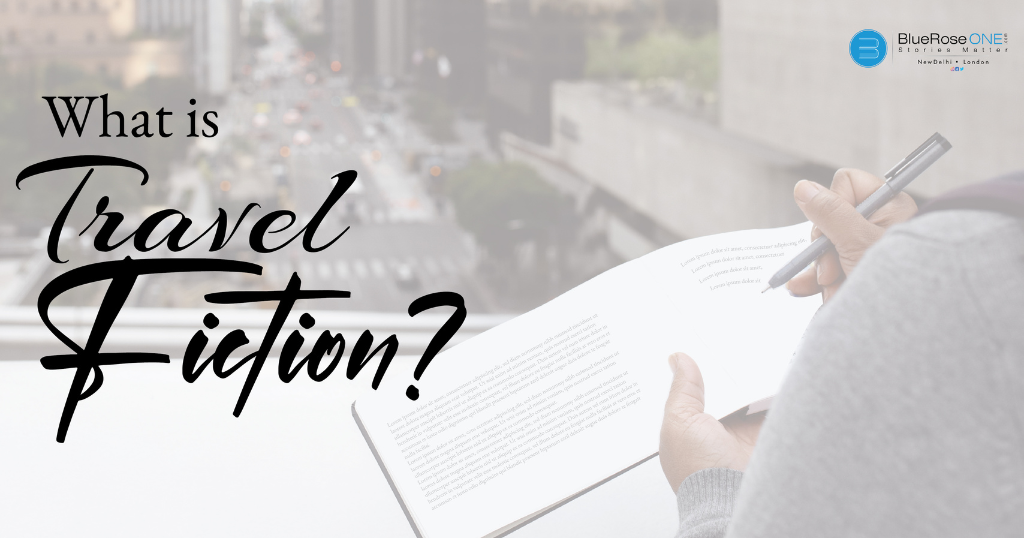
Everything to Know about Travel Fiction: Meaning, Definition & more
In a world where technology constantly blurs the lines between reality and imagination, the concept of fictional travel has emerged as a fascinating phenomenon. Unlike conventional travel, which involves physically traversing landscapes, fictional travel takes us on a journey through the realms of imagination, literature, and virtual reality. In this blog post, we will delve into the enchanting world of fictional travel, exploring its various forms, its impact on our minds, and the reasons why it continues to captivate the hearts of many. Read: Amazon Ads for Authors: How Authors Can Promote Their Books Through Amazon Ads Fictional travel, a captivating concept that transcends physical boundaries, has a rich history and a profound impact on human consciousness. This unique form of exploration takes individuals on a journey through the realms of imagination, whether in literature, virtual reality, or cinema. In this exploration of the history and importance of fictional travel, we delve into its origins, evolution, and the significant role it plays in shaping our understanding of the world. Historical Roots Literary Exploration: The 20th Century and Beyond Virtual Reality and Technological Advancements Importance of Fictional Travel The Escapism of Literature Virtual Reality: A Technological Odyssey Cinematic Odyssey: From the Silver Screen to Alternate Realities The Psychological Impact The Allure of the Unknown Historical Roots:The roots of fictional travel can be traced back to ancient mythology and folklore. Tales of gods and mythical creatures, epic adventures, and otherworldly realms served as a form of mental escapism for ancient cultures. These stories, often passed down through oral traditions, allowed individuals to traverse imaginative landscapes and grapple with fundamental questions about existence, morality, and the nature of the universe.As societies evolved, so did the means of storytelling. The advent of written language gave rise to epic poems, such as Homer’s “The Odyssey” and Virgil’s “The Aeneid,” which took readers on fantastical journeys across uncharted territories. These early works laid the foundation for the concept of fictional travel, establishing the power of storytelling to transport minds beyond the confines of reality. Literary Exploration:The Renaissance marked a significant period in the history of fictional travel. The revival of interest in classical literature led to the creation of works that expanded the boundaries of imagination. Authors like Jonathan Swift with “Gulliver’s Travels” and Dante Alighieri with “The Divine Comedy” wove intricate tales that explored not only physical landscapes but also the depths of human experience and moral dilemmas.During the Romantic era, writers like Mary Shelley, Edgar Allan Poe, and Jules Verne further pushed the boundaries of fictional travel. Shelley’s “Frankenstein” delved into the consequences of playing with the forces of life, while Verne’s “Twenty Thousand Leagues Under the Sea” took readers on a mesmerising underwater expedition, stimulating curiosity about unexplored realms. The 20th Century and Beyond:The 20th century witnessed a surge in fictional travel across various mediums. Science fiction, in particular, became a powerful vehicle for exploring futuristic landscapes and alternate realities. Authors like Isaac Asimov, Arthur C. Clarke, and Philip K. Dick envisioned worlds beyond the scope of contemporary understanding, challenging readers to contemplate the possibilities of the future.The rise of cinema brought fictional travel to new heights. Blockbuster franchises like “Star Wars,” “The Matrix,” and “Avatar” transported audiences to galaxies far, far away, or simulated realities that defied the laws of physics. The visual spectacle of these films not only entertained but also expanded the collective imagination, influencing cultural perspectives and societal aspirations. Virtual Reality and Technological Advancements:In the 21st century, technological advancements have propelled fictional travel into the realm of virtual reality. The advent of VR has enabled individuals to step into immersive environments, blurring the lines between fiction and reality. Virtual tourism, educational simulations, and interactive storytelling have redefined the way people experience fictional travel, offering a level of engagement and presence previously unimaginable. Importance of Fictional Travel:Fictional travel serves a crucial role in human development and understanding. It provides a safe space for exploring complex emotions, moral quandaries, and societal issues. By immersing ourselves in imaginary worlds, we gain new perspectives, fostering empathy and cultural sensitivity.Moreover, fictional travel stimulates creativity and innovation. The ability to envision fantastical landscapes and scenarios encourages individuals to think beyond the confines of the present, sparking ideas that can shape the future. It cultivates a sense of wonder, curiosity, and the belief that there is always more to discover. The Escapism of Literature:One of the earliest forms of fictional travel was through literature. Books have the magical ability to transport readers to far-off lands, distant time periods, and alternate realities. Whether it’s the whimsical landscapes of Wonderland in Lewis Carroll’s “Alice in Wonderland” or the hauntingly beautiful realms of Middle-earth in J.R.R. Tolkien’s “The Lord of the Rings,” literature allows us to escape the confines of our daily lives and immerse ourselves in fantastical worlds.As we turn the pages, we become explorers, navigating uncharted territories and meeting characters that challenge our perceptions. The power of words takes us beyond the constraints of time and space, providing a passport to limitless adventures. From science fiction to fantasy, each genre opens a gateway to a unique form of fictional travel, inviting readers to embark on a journey of the mind. Virtual Reality: A Technological OdysseyIn recent years, technological advancements have given rise to a new dimension of fictional travel: virtual reality (VR). VR allows individuals to step into alternate realities, experiencing sights, sounds, and sensations that feel remarkably real. Whether it’s exploring ancient civilizations, diving into the depths of the ocean, or soaring through the cosmos, virtual reality has the potential to redefine the way we perceive travel.Virtual tourism is becoming increasingly popular, enabling people to visit destinations without leaving the comfort of their homes. The immersive nature of VR provides a sense of presence, blurring the boundaries between fiction and reality. As we don VR headsets, we can find ourselves wandering through the bustling streets of Tokyo one moment and standing on the surface of Mars the next. The allure lies in the ability to traverse…
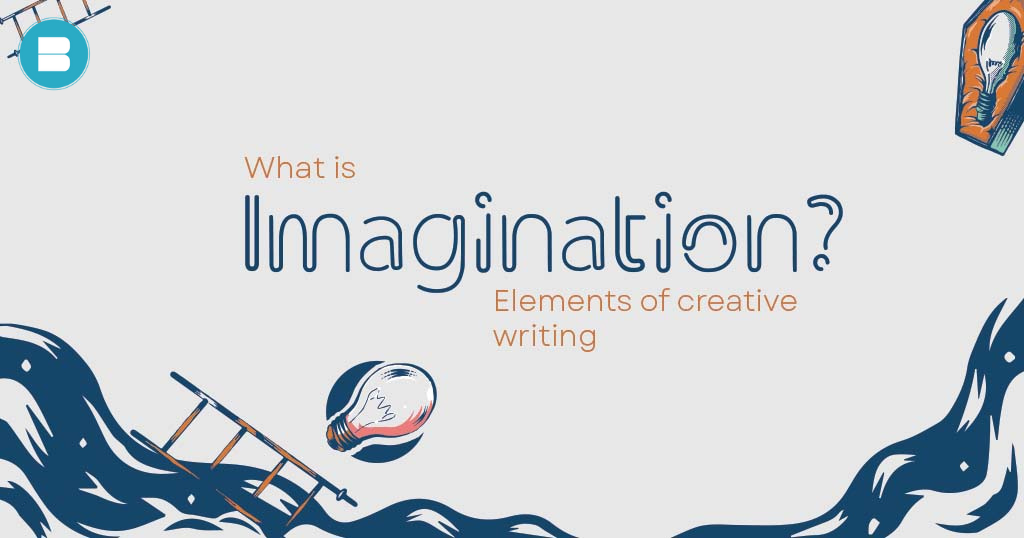
What is Imagination? Elements of Creative Writing.
Imagination is a boundless realm where ideas come to life, stories take shape, and worlds are crafted. It’s the driving force behind every captivating narrative, and it holds the key to unlocking the magic of creative writing. In this blog, we delve into the elements of creative writing that are fueled by imagination, exploring how to harness its power to craft compelling stories Understanding imagination and its role in writing Imagination is the canvas upon which writers paint their stories. It’s the ability to conjure vivid images, emotions, and scenarios in our minds, transcending the limits of reality. In the realm of creative writing, imagination serves as the foundation for storytelling, allowing writers to transport readers to new dimensions and experiences. Imagination and Writing: A Symbiotic Relationship Imagination and writing share an intricate symbiotic relationship, each enhancing the other’s potential to craft captivating narratives that capture readers’ hearts and minds. Writing acts as the vessel that channels the boundless energy of imagination, transforming abstract ideas into concrete, relatable stories that readers can immerse themselves in. Imagination, on the other hand, supplies the raw materials, infusing the writing process with creativity, depth, and the power to evoke emotions. Read: How to Become a Travel Writer – A Complete Guide on Travelogue Writing Imagine a scenario where the writer envisions an enchanting forest illuminated by the soft glow of fireflies. This mental image is a product of their imagination. However, it’s through the act of writing that this imagery takes shape and becomes accessible to others. As the words flow onto the page, the scene materialises, and readers can envision the magical forest just as vividly as the writer did. Here, imagination laid the foundation, and writing built the bridge to share it with others. Consider a fictional story where a young protagonist embarks on a daring adventure to save their kingdom. The twists and turns of the plot, the vivid landscapes, and the complex characters are all fruits of the writer’s imagination. However, without skillful writing to weave these elements together, the story might remain a jumble of disconnected thoughts. Writing provides the structure that allows imagination’s creations to be expressed coherently, drawing readers into a world they can explore. You may also like: 100+ Powerful Descriptive Adjectives to Make Your Writing Vivid Elements of Creative Writing Nurtured by Imagination Narrative Paragraphs: Imagination breathes life into narrative paragraphs, where characters, plots, and settings intermingle to create a cohesive story. It enables writers to craft dynamic characters with distinct personalities and motivations, driving the plot forward with unexpected twists and turns. The magic of imagination transforms mundane scenarios into exciting adventures that captivate readers.For example, consider a mundane situation where a character is walking to work. With imagination, this simple act can turn into an adventure. Perhaps the character stumbles upon a hidden portal that leads to a fantastical realm, setting the stage for an unexpected journey filled with challenges and discoveries. Descriptive Paragraphs: Imagination adds depth and colour to descriptive paragraphs, allowing readers to visualise scenes and settings as if they were standing amidst them. Writers use imaginative language to evoke sensory experiences, painting a sensory-rich tapestry that readers can immerse themselves in. Whether it’s the scent of blooming flowers or the rustling of leaves, imagination fuels descriptive writing. Imagine describing a forest scene with a touch of imagination. Instead of just stating “the trees were tall,” you could evoke a vivid image with “towering trees whispered secrets to the sky, their branches reaching out like ancient storytellers sharing tales with the clouds.” Exploring Essay Formats: Even in essays, imagination plays a crucial role. It guides writers in generating unique perspectives and insightful analyses. Imagination encourages writers to think outside the box, infusing essays with creative interpretations that engage readers and stand out in a sea of conventional approaches.For instance, in an analytical essay about a historical event, you could imagine being a fly on the wall during a pivotal moment. This imaginative approach could offer fresh insights into the emotions, motivations, and unspoken dynamics of the event, enriching your analysis. You may also read: Top 10 Rhetorical Devices Every Writer Should Know Steps to Channeling Imagination in Writing Mindful Observation: Imagination thrives on observation. Pay attention to the world around you—the people, places, and experiences. Observe the nuances, emotions, and interactions that often go unnoticed. These observations can serve as seeds for imaginative stories.Suppose you observe a hushed conversation between two strangers at a train station. With imagination, you could speculate on their identities, motivations, and the secrets they’re sharing, weaving a tale of intrigue and suspense. Dreaming Beyond Limits: Embrace the freedom of your imagination. Allow yourself to dream beyond the boundaries of reality. What if animals could talk? What if gravity didn’t exist? These fantastical scenarios can spark creative ideas that lead to innovative storytelling.Think about a world where humans communicate with animals. You could imagine a heartwarming story where a young girl forms an unlikely friendship with a talking squirrel, leading to adventures that bridge the gap between human and animal perspectives. Embracing What-Ifs: Imagination is fueled by curiosity. Ask “what if” questions that challenge the norm. What if time travel were possible? What if superheroes were real? Exploring these hypothetical scenarios opens the door to imaginative narratives.Imagine a society where everyone possesses a unique superpower. How would this shape relationships, power dynamics, and the concept of heroism? By exploring these what-ifs, you create a world ripe for imaginative exploration. Creating Connections: Imagination thrives when ideas collide. Combine seemingly unrelated concepts to create something new. Merge historical events with futuristic technology or blend cultural traditions with modern settings. These juxtapositions can lead to unique and compelling stories.Consider a story set in a Victorian steampunk world where advanced technology coexists with the elegance of the 19th century. This fusion of eras adds depth and intrigue to your narrative, sparking readers’ imaginations with the possibilities of a beautifully complex world. Diving into Emotions: Imagination isn’t just about visuals; it’s about emotions too. Dive deep into the emotional landscapes…
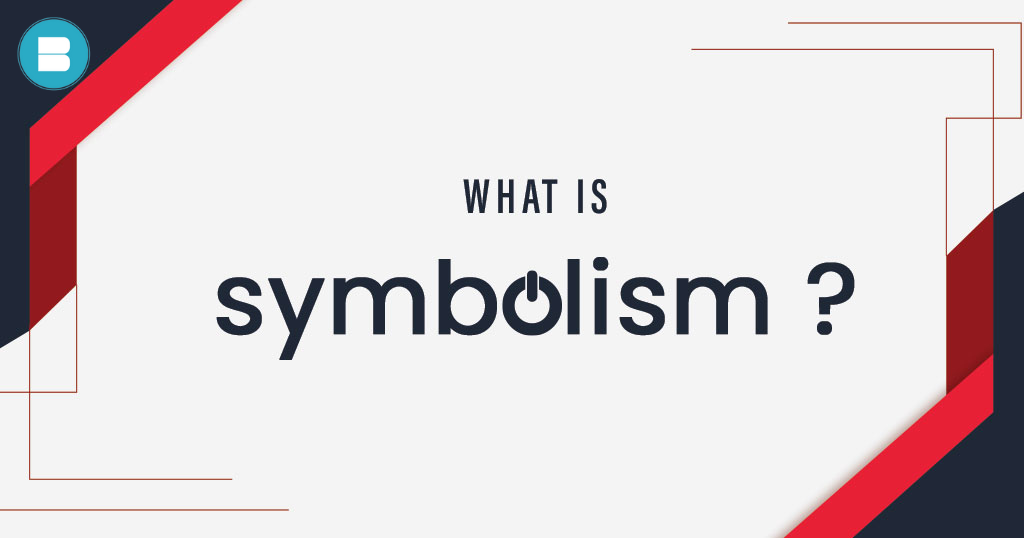
What is Symbolism? Definition, Examples and Types of Symbolism as a literary device
Symbolism is a literary device or technique that uses symbols to represent ideas, qualities, or concepts beyond their literal meaning. It is a way for authors to convey deeper meanings and add layers of complexity to their works. Symbols can take various forms, such as objects, actions, characters, or settings, and they often carry symbolic significance that goes beyond their immediate presence in the story. Symbols can be universal, with widely recognized meanings, or they can be specific to a particular work or culture. For example, a white dove is often used as a symbol of peace and purity, while a red rose can symbolize love or passion. Symbols can also be more abstract, representing ideas or emotions, such as a journey symbolizing personal growth or a broken mirror representing shattered self-image. Read: Why are literary devices used? Types of literary devices that you should know. The power of symbolism lies in its ability to evoke emotions, create connections, and invite readers to engage in deeper interpretation. It allows authors to communicate complex themes, messages, or social commentary in a more subtle and evocative manner. By using symbols, writers can transcend the boundaries of literal language and tap into the collective unconscious, tapping into universal human experiences and archetypes. Interpreting symbolism in literature often involves analyzing the context, recurring motifs, and the author’s intent to uncover the underlying meanings and messages. However, it’s important to note that symbolism can be subjective, and different readers may interpret symbols differently based on their own experiences and perspectives. You may also read: The Mighty Red by Louise Erdrich: A Deep Dive into Her Latest Novel You may also read: 10 Classic Flat Character Examples in Literature and Film What are the Types of Symbolism? Symbolism in literature can take various forms and serve different purposes. Here are some common types of symbolism: Object Symbolism: Object symbolism involves using objects or things to represent abstract ideas or concepts. For instance, a key can symbolize unlocking hidden truths or gaining access to new possibilities. In a story, a character finding a key could signify their quest for knowledge, enlightenment, or personal truth, overcome obstacles, or open doors to new opportunities. Through the use of object symbolism, the key takes on a deeper meaning, adding layers of metaphorical significance to transformation. The key becomes a tangible representation of their desire to tell a narrative, inviting readers to reflect on the broader themes and messages conveyed by the story. Color Symbolism: Color symbolism involves the use of colors to convey meaning or evoke emotions in a literary or artistic context. For example, the color red often symbolizes passion, love, or danger. In a story, a red rose may represent intense love or desire, while red blood may symbolize violence or sacrifice. On the other hand, blue is commonly associated with calmness or sadness. In a painting, a predominantly blue landscape might evoke a sense of tranquility or melancholy. By utilizing color symbolism, writers and artists can imbue their works with deeper layers of interpretation, allowing colors to communicate themes, moods, or character traits to the audience, enhancing the overall impact and resonance of the piece. Animal Symbolism: Animal symbolism involves the use of animals to represent specific qualities, characteristics, or ideas in literature, art, or cultural contexts. For instance, a lion is often seen as a symbol of strength, courage, and leadership. In a story, a character with lion-like qualities may embody these traits or display dominance and bravery. Conversely, a dove is commonly associated with peace, purity, and innocence. In a painting, a dove carrying an olive branch can represent a desire for harmony and reconciliation. By employing animal symbolism, writers and artists tap into the collective cultural meanings associated with certain animals, enhancing the depth and resonance of their work while providing readers or viewers with visual or metaphorical cues to interpret and engage with the intended themes or messages. Nature Symbolism: Nature symbolism is the use of elements from the natural world to convey deeper meanings and evoke emotions. For example, a barren landscape, with its dry and lifeless features, may symbolize desolation, loneliness, or loss in a literary work. It can serve as a visual representation of emotional or spiritual emptiness. Conversely, a blooming flower bursting with vibrant colors and fragrances can symbolize growth, renewal, or the beauty of life. The flower’s transformation from a bud to full bloom can parallel personal growth or the emergence of hope in a character’s journey. Nature symbolism allows writers and artists to tap into the universal associations and metaphors found in the natural world, offering a rich tapestry of imagery and symbolism to enhance the depth and resonance of their work. Character Symbolism: Character symbolism involves the use of specific characters to represent or embody certain ideas, archetypes, or qualities. For instance, a wise old sage character in a story can symbolize wisdom, knowledge, or guidance. This character often possesses deep insights, provides valuable advice, and serves as a mentor figure for other characters. Through their actions, dialogue, and interactions, the wise old sage becomes a symbol of wisdom and enlightenment, guiding the protagonist or other characters on their journey of self-discovery or growth. By embodying these qualities, the character becomes a focal point for the exploration of themes related to wisdom, knowledge, and the search for truth. Character symbolism enhances the narrative by providing a tangible representation of abstract concepts, allowing readers to connect with and understand these ideas on a deeper level. Religious or Mythological Symbolism: Religious or mythological symbolism draws upon symbols and imagery from religious or mythological contexts to convey deeper spiritual or allegorical meanings. An example of this is the serpent in biblical stories, which often symbolizes temptation or evil. In the biblical narrative of Adam and Eve in the Garden of Eden, the serpent is depicted as a cunning and deceptive creature that entices Eve to eat the forbidden fruit, leading to their expulsion from paradise. The serpent’s role in this story serves as a metaphor for the temptations and…
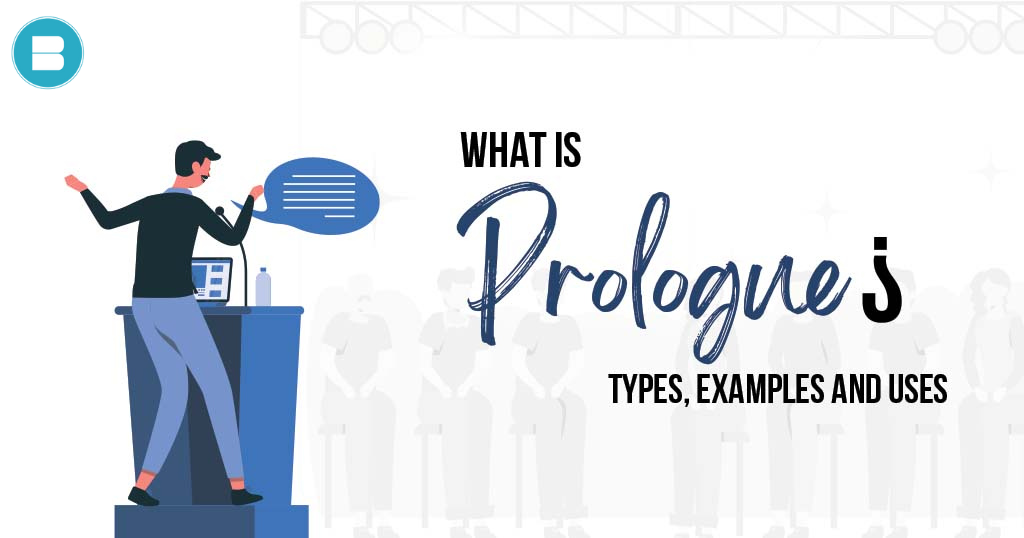
Prologue Explained: Definition, Purpose, and Powerful Examples
Imagine a world where secrets are buried deep and the truth is hidden behind closed doors. A prologue is like a key that unlocks the door to this hidden realm, revealing a glimpse of what lies ahead. It sets the stage for the journey that is to come, providing context and background that will help you navigate the twists and turns of the story. Prologues can take many forms, from an introduction to the characters, to a look into the past that shapes the present. They can be written from a single point of view or from an omniscient narrator, giving you a bird’s-eye view of the world. Think of a prologue as a map, guiding you through the unknown territories of a story. It may not be necessary for every tale, but when used correctly, it can enhance your understanding and appreciation of the journey ahead. So, open the door and step into the world of the prologue, and let the story unfold. You may also read: How to Publish a Book? | Publish Your Book | BlueRoseOne Many people have a doubt “What is Prologue“? Prologue comes from the Greek word –prólogos where ‘pró’ means before and ‘logos’ means word. A prologue is like the curtain raising before the main show, it serves as an introduction to the literary work, setting the scene for the story to unfold. It’s often placed at the beginning, like an overture, to give the audience a glimpse of what’s to come. Now there are three terms used quite a lot Prologue, Preface, and Foreword. They all contain background information and set the story but What is the difference between the three? A prologue is a section that is part of the main story and is used to provide background information, introduce characters or themes, or set the scene for the story that is about to unfold. It is written in the same style and tone as the rest of the book and is often used to provide important information that is needed to understand the story. A preface, on the other hand, is typically written by the author and provides information about the context in which the book was written, the author’s inspiration for the story, or the research that was done to create the work. It is often written in a more personal tone and can give readers insight into the author’s creative process. You may also like: The Mighty Red by Louise Erdrich: A Deep Dive into Her Latest Novel A foreword, meanwhile, is usually written by someone other than the author, such as a literary critic, a historian, or a well-known public figure. It is intended to provide an endorsement or recommendation of the book and to give readers an idea of why the book is worth reading. It often provides an overview of the book’s themes and significance. The main difference between these three is that a prologue is a part of the story, a preface is written by the author, and a foreword is written by someone else. They all provide background information and context to the book, but they come from different perspectives. Now every writer writes a different story, every story needs a unique prologue. Therefore, using these tips to write a prologue will help to ensure that the prologue serves its intended purpose and enhances the overall story. You may also like: Top 10 Real Life Stories to Read Online Prologues, like the first sip of fine wine, are a tantalizing introduction to the literary feast that lies ahead. They come in many forms, each with a unique purpose, much like a wine list that offers a variety of options to suit different palates. So here is your wine list of Prologue – You may also read: The Rise of Shakti By Megha Dinesh: Book Review In conclusion, When writing a Prologue, it’s important to consider if it is necessary, establish the tone and style of the story, provide important background information, hook the reader, keep it short and practice, practice, practice. With these tips, a Prologue can enhance the overall story and serve its intended purpose. Prologues can take many forms, from an introduction to the characters, to a look into the past that shapes the present. They can be written from a single point of view or from an omniscient narrator, giving the reader a bird’s-eye view of the world. Think of a prologue as a map, guiding the reader through the unknown territories of a story. You may also like: The Rise of Audiobooks: A Gamechanger for Modern Bookworms Tell us your favourite prologue and till then… Publish your book for free with BlueRoseONE and become a bestselling author. Don’t let your dream of becoming an author fade away, grab the opportunity now and publish your book – be it fiction, non fiction, poetry or more. Happy Reading!
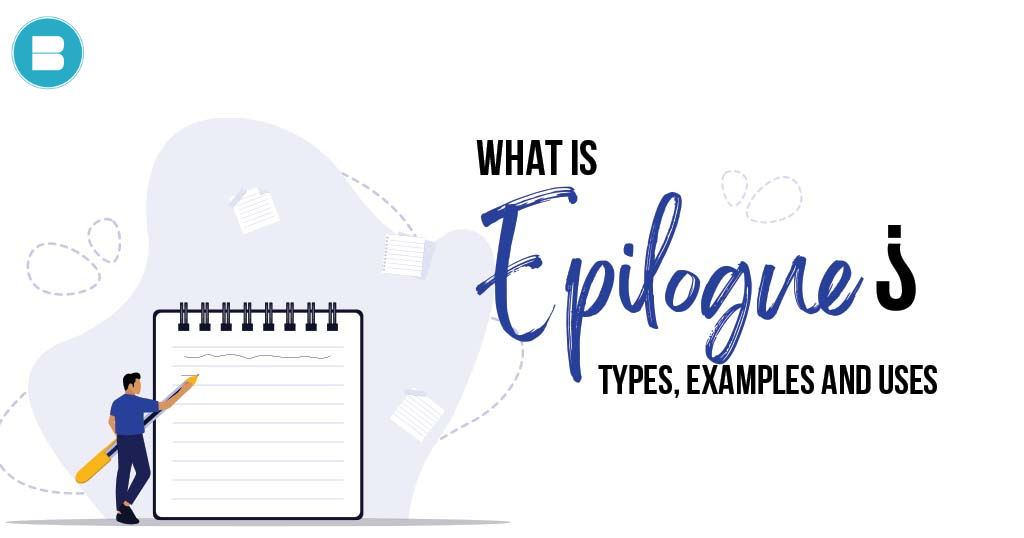
Epilogue: Definition, Types, Uses, & Examples – BlueRoseOne
As the final pages of the book came to a close, the reader couldn’t help but feel a sense of longing for the characters and the world they had come to know so well. But just as all good things must come to an end, so too must all great stories. And thus, the author gifted the reader with an epilogue – a glimpse into the future, a final farewell to the beloved characters, and a tying up of loose ends. The epilogue painted a picture of the characters’ lives after the events of the story, their trials and triumphs, their joys and sorrows. It was a reminder that life goes on, and that the characters, just like the reader, would continue to experience it all. It was a bittersweet goodbye, but also a comforting one, as the reader knew that the characters would always hold a special place in their heart. And as the reader closed the book, they couldn’t help but smile, feeling grateful for the journey they had been on and the memories they had made alongside the characters. The end was only the beginning. Epilogue comes from the Greek word – epílogos where ‘epí’ means in addition and ‘logos’ means word – when combined means conclusion. This word was first used in the 15th century. Every genre, every book, every story, every character has an epilogue of their own because it is something which cannot be duplicated. You may also like: Online Books vs. Traditional Books | Pros and Cons There are many ways to write a beautiful epilogue but here I have mentioned a few pointers that will help you curate a heartwarming epilogue of your book – An epilogue is a powerful tool that can provide closure, reveal characters’ fates, and reflect on the story’s themes. It is the final chapter of a story and must be written carefully to ensure that it serves its purpose and provides a satisfying conclusion to the story. You may also like: 20 Satire Examples in Real-World Every Writer Should Know You may also like: The Rise of Audiobooks: A Game-Changer for Modern Bookworms An example of an epilogue that provides closure is in J.K. Rowling’s Harry Potter and the Deathly Hallows. In the epilogue, set nineteen years after the story’s main events, readers see Harry, Ron, and Hermione all grown up and sending their own children off to Hogwarts School of Witchcraft and Wizardry. This epilogue provides closure by showing that the characters have moved on with their lives and that the story’s conflicts have been resolved. Another example of an epilogue that reveals the characters’ fates is in F. Scott Fitzgerald’s The Great Gatsby. In the epilogue, readers learn that Gatsby’s dream of winning back his lost love, Daisy, ultimately led to his death. This epilogue provides insight into Gatsby’s motivations and serves as a reminder of the tragic consequences of his actions. An example of an epilogue that serves as a reflection on the story’s themes is in Jane Austen’s Pride and Prejudice. In the epilogue, readers see the characters five years after the story’s main events, and it is clear that the main theme of the novel, the need to look beyond first impressions, has been learned and put into practice. The epilogue serves as a reminder of the themes and the moral of the story. So if to put this entire blog in simple words, an epilogue provides the time for readers to reflect on the adventure they’ve just finished. You may also like: Top 10 Real Life Stories to Read Online It gives authors the opportunity to end the novel, but not necessarily without any unanswered questions. Well, you can never let the dear readers not want more… Publish your book for free with BlueRoseONE and become a bestselling author. Don’t let your dream of becoming an author fade away, grab the opportunity now and publish your book – be it fiction, non fiction, poetry or more. Happy Reading!
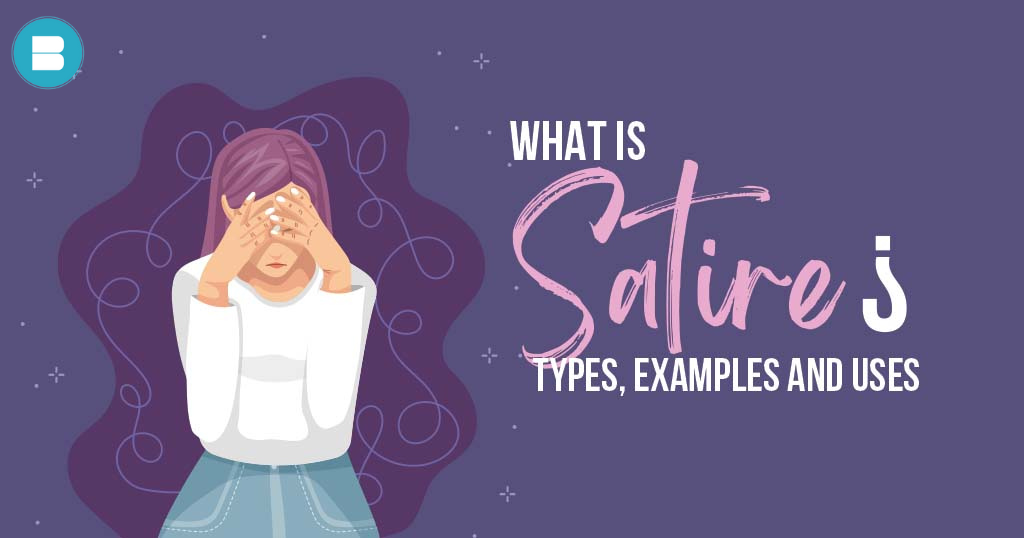
What is Satire: Definition, Types, Uses, & Examples.
Many people have a doubt “What is Satire“? Satire is a literary device that artists use to mock the foolishness and wickedness in human nature and society. It’s like holding a mirror to the world, pointing out its flaws and imperfections with a healthy dose of humor and irony. Read: Here’s a list of 10 Best Libraries in Pune for Bookworms. Satire pokes fun at the absurdity of people’s behavior and ideas, as well as societal institutions and other creations. It uses a variety of tones, from amusement to contempt, to bring attention to the shortcomings of a subject and inspire change. It’s like a gentle nudge, reminding us to take a step back and see the world through a different lens. Satire is not just a form of entertainment, but a powerful way to create awareness and bring about positive change. For example, Jonathan Swift’s “A Modest Proposal,” in which the author provides a remedy to the problem of overpopulation and poverty in Ireland in the 18th century, is a thorough example of satire. The suggestion is that the poor sell their children as food for the wealthy in order to reduce the number of poor people while boosting the country’s wealth. The plan is presented in a serious and rational manner, yet it is clearly intended to be outrageous and stupid, emphasising the ridiculousness of the time’s societal attitudes toward poverty and overpopulation. Swift’s use of sarcasm and exaggeration allows him to mock the upper classes’ callousness and apathy toward the condition of the poor. He deconstructs the notion that the poor are nothing more than a burden on society, and that their lives and well-being are worth less than the economic benefits they may contribute. Swift’s suggestion is a stinging critique of cultural attitudes toward poverty and overpopulation, as well as a call to action for change. Swift’s use of sarcasm and exaggeration allows him to mock the upper classes’ callousness and apathy toward the condition of the poor. He deconstructs the notion that the poor are nothing more than a burden on society, and that their lives and well-being are worth less than the economic benefits they may contribute. Swift’s suggestion is a stinging critique of cultural attitudes toward poverty and overpopulation, as well as a call to action for change. You may also like: Top 10 Real Life Stories to Read Online What is Satire and its importance? Why is it used so often? Satire is an important literary device that has several advantages for both the writer and the readers: Satire is a literary device that employs various techniques, such as irony, exaggeration, and ridicule to attack and criticize a particular subject or idea. For a satire to be successful, it must have five key elements: attack, judgment, wordplay, humor, and the desire for reform. For example, a satire will begin by attacking a certain subject or idea through the use of irony, and then make a judgment about it. The satire then uses clever language, wordplay, and humor to create laughter and make the person in question aware of their faults, with the ultimate goal of inspiring change or reform. The five elements are – People may mix up satire and parody because both employ similar strategies to convey a point or generate a hilarious or satirical impact, such as irony, comedy, and exaggeration. Furthermore, satire and parody can be found in similar kinds of literature such as plays, novels, and essays, as well as in other forms of media such as cartoons, television shows, and movies. You may also like: International Publishing: Expanding your beyond borders So, what is the difference between Satire and Parody? Satire and parody are literary devices that are connected but have fundamental differences. Satire is a type of social and political criticism in which individuals, institutions, or society as a whole are criticised and mocked via the use of irony, comedy, and exaggeration. It seeks to reveal and correct vices, follies, excesses, and flaws in human nature or society. Satire is frequently used to emphasise the absurdity or ridiculousness of a certain issue in order to make a point or affect change. A parody, on the other hand, is a type of satire that imitates the style and manner of a certain work or author for hilarious or sarcastic effect. It frequently exaggerates or exaggerates the original work’s features in order to achieve a humorous or sarcastic effect. A parody is not always intended to critique or mock a specific subject, but rather to mimic the style or conventions of a specific type of literature or art. Simply stating, satire is a broad phrase that includes parody; nevertheless, parody is a subset of satire that focuses on imitating and exaggerating the style and conventions of a certain work or author. To understand the spectrum of satire better, here are a few examples, To conclude this entire satirical journey, I’d like to say that Satire is like a lens, magnifying and highlighting the absurdity of people’s behavior and ideas, as well as societal institutions and other creations. You may also like: How to make book design more appealing to the readers Satire is not just a form of entertainment, but a tool for creating awareness and bringing about positive change. It can expose and criticize social and political issues, challenge and subvert established ideas and beliefs, and entertain and make readers laugh. It’s a gentle nudge, reminding us to take a step back and see the world through a different perspective. Publish your book for free with BlueRoseONE and become a bestselling author. Don’t let your dream of becoming an author fade away, grab the opportunity now and publish your book – be it fiction, non fiction, poetry or more. Happy Reading!
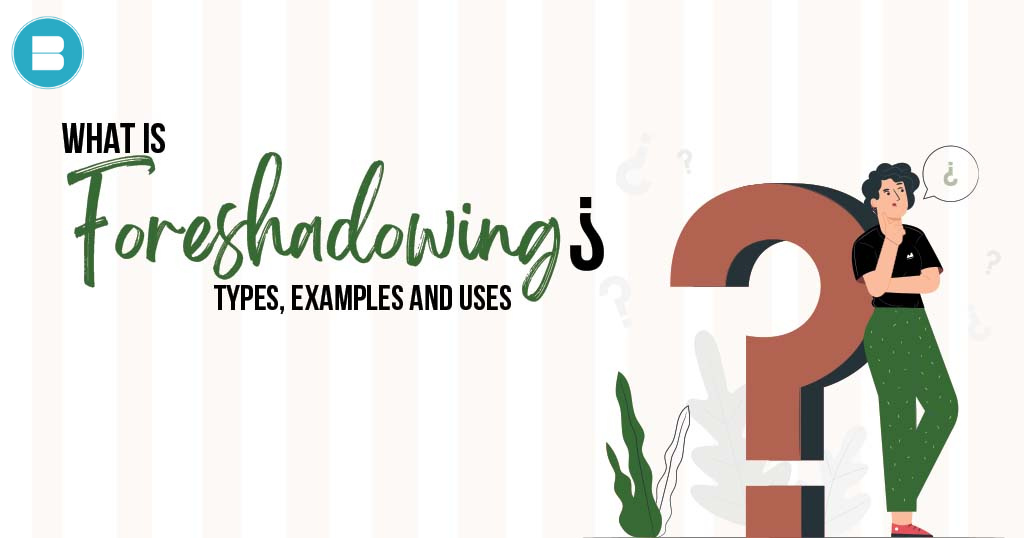
Foreshadowing: Definition, Types, Uses & Examples
Many people have a doubt “What is Foreshadowing“? Foreshadowing is a clever tool that scribes wield to give readers a sneak peek of what’s to come in a tale. When executed with finesse, it weaves a web of intrigue and anticipation that keeps readers on the edge of their seats. It paints a picture of what’s to come, be it a character’s actions or the outcome of a plot. This not only elevates a reader’s experience but also enriches the story’s message and allows readers to draw parallels with other literary works and themes. Read: List of 10 Most Popular Romance Novel Books in 2022. For example, in Samuel Taylor Coleridge’s poem “The Rime of the Ancient Mariner,” the act of the mariner killing the albatross serves as a powerful foreshadowing device. The albatross, a symbol of good fortune, is seen as a positive omen by the sailors. However, the mariner, without any apparent reason, kills the bird, foretelling the misfortunes that will befall the ship and its crew. The death of the albatross also symbolizes the mariner’s guilt and curse, which he cannot shake off. The sailors, recognizing the bird as a bad omen, attempt to hang it around the mariner’s neck. This foreshadowing of the albatross’s death creates a sense of unease and anticipation in the readers, as they know that something bad is going to happen as a result of the mariner’s actions, and it also serves to highlight the theme of guilt and the consequences of one’s actions. Read: Book Review – Fletcherism a Book by Vaishali Jog A particular line from Samuel Taylor Coleridge’s poem “The Rime of the Ancient Mariner” that highlights the use of foreshadowing is: “He prayeth best, who loveth bestAll things both great and small;For the dear God who loveth us,He made and loveth all.” This line, spoken by the mariner to the wedding guest, foreshadows the mariner’s eventual redemption and spiritual enlightenment. The mariner is expressing his understanding of the importance of loving all things and the power of prayer, which he learns through the suffering he experiences as a result of killing the albatross. This foreshadows the mariner’s eventual realization of the error of his ways and his ability to find forgiveness and redemption. This line also highlights the theme of love and redemption, which is a significant aspect of the poem. You may also like: Top 10 Hugo-Award Winning Novels You Must Read What are the two forms of Foreshadowing? Both forms of foreshadowing can be used together to create a sense of suspense and anticipation in the readers. Direct foreshadowing can be used to make the readers aware of what is to come, while indirect foreshadowing can be used to add depth and complexity to the story. You may also like: List of Nobel Prize Winners in India (Updated) What is Foreshadowing ? What is its importance in Literature? Foreshadowing is an important literary device that allows authors to: You may also like: The Rise of Self-Publishing and What it means for authors What is the difference between Foreshadowing, Flashback, and Flashforward? Foreshadowing, flashback, and flashforward are all literary devices that manipulate time in a story, although they are used in various ways. Foreshadowing is a technique used to foreshadow or hint at events that will occur later in the story. It builds suspense and anticipation by showing the reader a preview of what is to come, but it does not depict the action itself. Flashback is a method that disrupts the chronological order of events in a story to reveal a prior incident. It is used to provide context or to reveal a character’s motivations. Flashbacks are typically prompted by a specific incident in the present, and they frequently assist the reader in better understanding the current situation. Flashforward is a technique for displaying an event that will occur in the future. It is employed to generate suspense or to hint at the story’s outcome. Flashforwards are typically prompted by a specific incident in the present, and they frequently assist the reader in better understanding the current situation. Simply stating, foreshadowing is a technique used to hint at a future occurrence, flashback is a technique used to depict a previous event, and flashforward is a technique used to show an event that will happen in the future. Lets look into some examples to help you understand foreshadowing from your favourite novels: You may also like: Online Books Vs. Traditional Books | Pros and Cons In conclusion, I’d say that Foreshadowing is like a secret handshake between the writer and the reader, a subtle nod towards what’s to come. It weaves a web of intrigue and anticipation, painting a picture of what’s yet to be revealed. When executed with finesse, it keeps readers guessing and on the edge of their seats. It can be done in two ways, the direct and the indirect, both of which can be used to add layers of depth to a story. It’s like a trail of breadcrumbs leading readers to the climax, making the journey all the more exciting. Foreshadowing adds meaning to a story and helps readers draw parallels with other literary works and themes. It’s a powerful tool that elevates the reader’s experience and enriches the story’s message. Publish your book for free with BlueRoseONE and become a bestselling author. Don’t let your dream of becoming an author fade away, grab the opportunity now and publish your book – be it fiction, non fiction, poetry or more. Happy Reading!
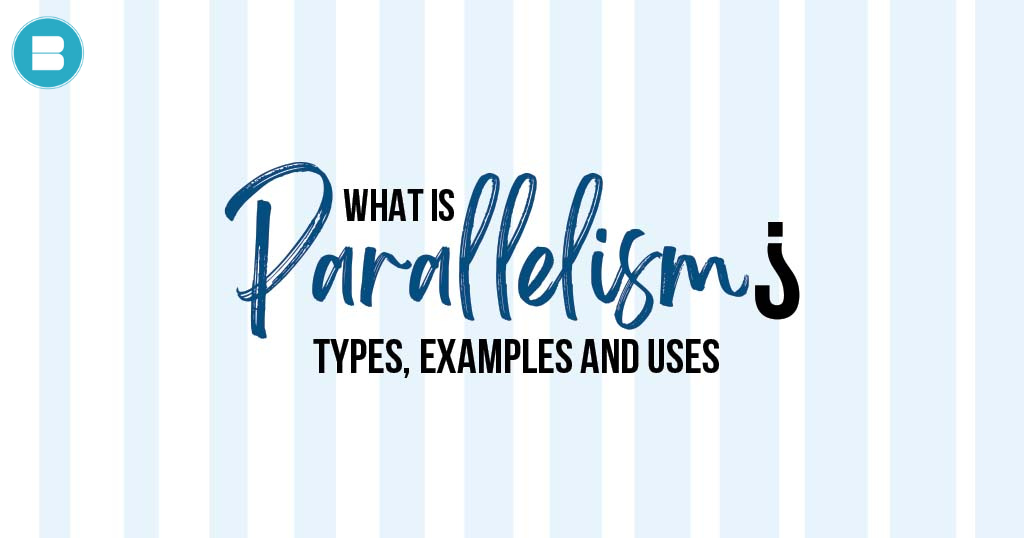
What is Parallelism: Definition, Types, Uses, & Examples.
When it comes to writing and speaking, parallelism is a literary device that involves the repetition of similar grammatical structures. This repetition can influence the structure of sentences, but it can also have an impact on the meaning and ideas being conveyed. What is parallelism? As a figure of speech, parallelism goes beyond just a grammatical technique and can include the repetition of a word or phrase for emphasis. Additionally, it can be used to create a parallel relationship between opposing ideas, using grammatical elements to emphasize contrast. Read: Here’s a list of Top 10 Most Popular Historical Fiction Books of all time. Parallelism can be used in many different forms of writing, from poetry and speeches to fiction and non-fiction. It is a powerful tool for emphasizing ideas and creating a sense of rhythm and flow in the language. For example, in the sentence “He was tall, dark and handsome,” the adjectives “tall,” “dark,” and “handsome” are parallel in structure, creating a sense of balance and symmetry. Here are some examples from different literary work that will help you understand Parallelism a bit better: To sum it all up, parallelism is a stylistic strategy that involves the recurrence of comparable grammatical structures or phrases throughout a series of sentences or clauses, creating a semblance of balance, cadence, and recurrence in the language. Parallelism can be utilised in writing to successfully portray ideas, themes, and emotions by creating various effects such as focus, balance, and rhythm. Read: What is Proofreading & How can you do it by yourself? The above examples show how parallelism can be employed in literature to build meaning and convey ideas in a clear and effective manner. Let us know which books mentioned above have you read… Happy Reading!
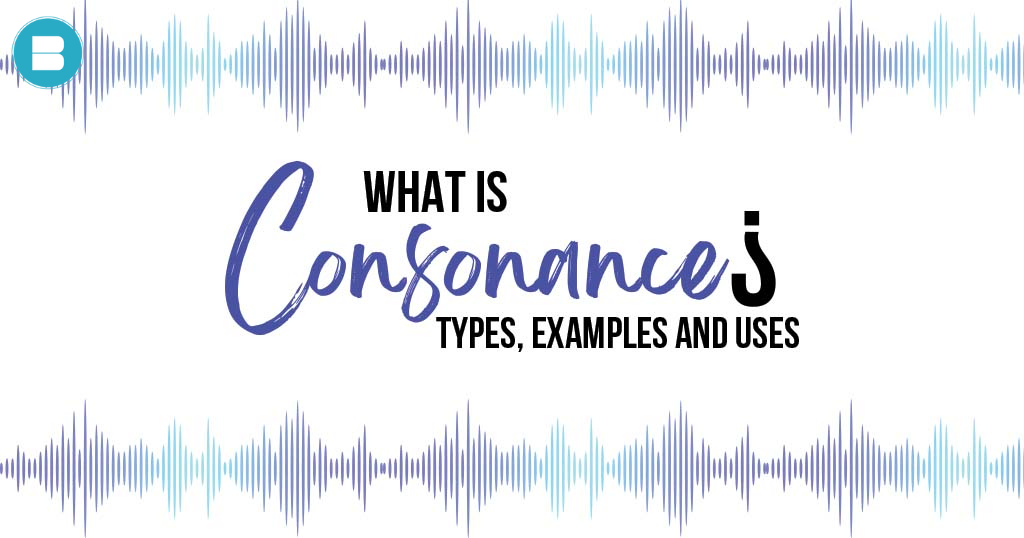
What is Consonance: Definition, Types, Uses, & Examples.
Many people have a doubt “What is Consonance“? Consonance is a literary magic trick, where words and sounds play together like a symphony. It’s the repetition of similar consonant sounds that creates a harmony that can be heard but not seen. It’s the “s” in “slip and slide” or the “h” in “hissing snakes” that make the words sing together. It’s not just the letters but the sounds they make that come together to create a symphony of words. Read: Learn what is Parallelism? Definition, Types, Uses, & Examples. Consonance is a secret weapon of poets, a way to make words dance and sing. It’s the repetition of like-sounding consonants that creates a musicality within a line of poetry. It’s a way to add depth and meaning to words, and to create a harmony that is pleasing to the ear. Poets use this device like a master composer, conducting a symphony of sounds to create an artistic language that resonates with readers and listeners alike. It’s a subtle yet powerful tool, that adds an extra layer of beauty to poetry, making it an experience for the senses. Simply stating, Consonance is a literary device that involves the repetition of similar consonant sounds, typically in close proximity to one another. This repetition can occur at the beginning, middle, or end of words, and it creates a sense of harmony and unity in the language. Read: Here’s a list of most interesting books of all time for Young adults. It can be used to create a specific mood or atmosphere in a piece of writing, and it can also be used to add emphasis or to create a sense of rhythm. Types of Consonance There are several types of consonance that can be used in literature, including: These are the main types of consonance, but there are many variations and combinations that can be used in literature. You may also read: Book Review: Lord of the Files by William Golding It is basically a repetition of the first letter sound therefore Consonance can often be confused with Alliteration and Assonance. So to make sure you don’t get confused, here is a brief difference between the three: As you already know till now what Consonance is, Alliteration is a type of consonance in which the initial consonant sound is repeated in a group of words. This repetition is often used for emphasis or to create a sense of rhythm. Alliteration can be used to draw attention to specific words or to create a sense of playful language. You may also like: 10 Magical Books That Combine Christmas and Fantasy For example, “Peter Piper picked a peck of pickled peppers” – the repetition of the ‘p’ sound. “She sells sea shells by the sea shore” – the repetition of the ‘s’ sound Assonance involves the repetition of similar vowel sounds, typically in close proximity to one another. Like consonance, it creates a sense of harmony and unity in the language and can also be used for emphasis and rhythm. Assonance can be used to create a sense of internal rhyme within a line of poetry or to create a specific sound pattern. For example, “grey day” – the repetition of the ‘e’ sound“How now brown cow” – the repetition of the ‘o’ sound“Fledgling feather” – the repetition of the ‘e’ sound It is obvious from these examples that consonance and assonance are two distinct sorts of literary devices employed to create a sense of harmony and wholeness in the language. Alliteration is also a sort of consonance. It’s important to note that these literary devices can overlap and can be used in combination with each other to achieve different effects. For example, alliteration can be used in conjunction with assonance to create a sense of internal rhyme and emphasis. So, Consonance is the repetition of similar consonant sounds, Alliteration is the repetition of the initial consonant sound and Assonance is the repetition of similar vowel sounds. You may also like: Positive Character Traits And Why They Are Crucial Some examples from novels that will help you to observe consonance: These examples show that any type of literature is rich with the use of literary devices such as consonance, which may be found throughout the text, not just in conversation or monologue, and can assist to create a feeling of balance, oneness, and prominence. Read: List of 10 Best Libraries in Hyderabad for Bookworms. In conclusion, Consonance is the symphony of words, where sounds and letters come together in harmony to create a musicality that echoes in the mind of the reader. So next time you read a poem, pay attention to the subtle yet powerful Consonance that lies within the lines, let it transport you to a world of beauty and wonder. You may also like: 7 Point Story Structure: Definition, Examples and More Happy Reading!
